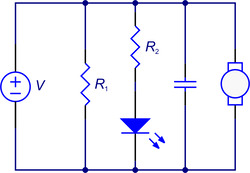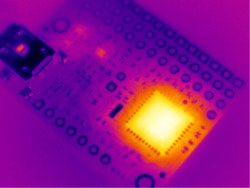Pololu Blog »
Pololu Blog (Page 91)
Welcome to the Pololu Blog, where we provide updates about what we and our customers are doing and thinking about. This blog used to be Pololu president Jan Malášek’s Engage Your Brain blog; you can view just those posts here.
Popular tags: community projects new products raspberry pi arduino more…
Parallel circuits
If you have a limited or informal electronics education, parallel circuits might be the kind of topic you glossed over or have forgotten about. After all, parallel circuits sounds like boring theory, and you want to get to the fun stuff. But, banging your head over a simple system that you think should just work isn’t much fun, and you can save yourself a lot of grief with a bit of awareness about the potential differences between a schematic and a physical circuit. Also, I’m a proponent of learning fundamentals and trying to really understand things, so we’ll start with a bit of the basic theory. Continued…
Simple LED circuit abstractions
The simple LED circuit from last time is a great first circuit for everyone interested in electronics because it is so forgiving. If you connect something backwards, you probably won’t break anything, and otherwise, it should just work. However, that forgiving nature of the circuit can beguile newcomers into thinking everything is that simple, and though there are many web pages out there discussing the circuit, they usually do not address the abstractions and simplifications that are in play and why we can use them in this instance. So, that’s the topic for this post. Continued…
Simple LED circuit
One of the simplest circuits you can build is an LED powered by a battery. Unfortunately, many people who think they know some electronics (and even multiple job interviewees with supposed electrical engineering degrees) cannot actually draw the schematic for the simple circuit or calculate the appropriate component values. Can you? Continued…
Estrella Intersects the Plane
 |
This art installation by Matthew Richard uses 10 OctoBrite DEFILIPPI modules, 80 RGB LEDs, 40 servos, 7 servo controllers, and an Arduino.
Featured link: http://cargocollective.com/mrichard/Estrella-Intersects-the-Plane
Abstractions
We should consider the general concept of abstraction in robotics a bit before moving on to more specific topics. Abstraction comes up a lot in computer science and programming, so I think people in that field are exposed to it early and often. Just about any program will have at least some user-made abstractions in it, be it a data structure or a subroutine, so programmers tend to be aware that the abstractions are just whatever they choose to make them and that they are not necessarily statements of absolute fact. In other introductory engineering contexts, at least in my experience, there is less of an explicit acknowledgment of the abstractions being used. Continued…
What's in a name?
At the risk of sounding like I’m telling you to eat your vegetables, I’m going to zoom out one more step from the last post about units and talk even more generally about the importance of names. Whatever you think of Juliet’s famous answer, the reality is that if you want to get someone a rose, or even just to talk about a rose, you need to know what it’s called. Naming things is a very powerful human skill that allows us not only to better communicate our thoughts but to better form our thoughts in the first place. Continued…
Know your units
How many volts of current are there in a bolt of lightning? That’s the kind of stupid question your local news anchor might ask while bantering with the weather guy. Perhaps your favorite cringe-inducing unit abuse is someone thinking light-years measure time or a model rocket enthusiast telling you that a newton-second is a little longer than a regular second. Of course, I made the same class of mistake when looking for a 1-amp battery, which I described in my previous post about battery capacity. That article addressed a specific instance of a general problem: not knowing or understanding units, which allow us to talk about and measure physical properties that we must understand whether we’re designing robots or baking cakes. Continued…
Understanding battery capacity: Ah is not A
My earliest electronics projects and my first robot were powered by regular alkaline batteries, and I didn’t think about current or the capacity of those batteries. The batteries were prominently labeled “1.5V”, and I was happy in my understanding that putting four in a battery holder got me to 6 volts; when the motors slowed down, it was time for new batteries. When I began designing my second robot, I found some 12V, 1A motors (what a “1-amp motor” might mean is a topic for another post) and promptly wasted many hours dragging parents and teachers to Radio Shack and car parts stores looking for a 12V, 1A battery. Continued…
Introduction to Jan's blog
My name is Jan Malášek, which is a Czech name, so the “J” is pronounced as an English “Y” (if you care, we can go over the last name in person, or you can consult your local Czech person). I grew up on the Big Island of Hawaii, spent five years in school in Massachusetts, and then moved to Las Vegas, Nevada to work on Pololu. I recently turned 30, and I’m still not the millionaire I had hoped to become at age 23 and then by age 25. Hitting 30 means it has been twenty years since I got started with electronics and ten years since I routed the first circuit board that said “Pololu” on it. Continued…
Jrk 12v12 TV Lift
This news report from the Philippines shows a custom TV lift using a Pololu Jrk 12v12 made by “gadget kid” Francisco Estrada III.

















